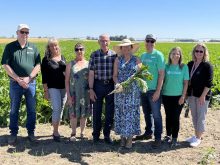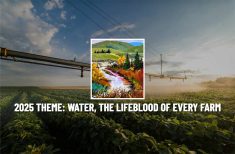Two-thirds of high school students who complete Alberta’s Green Certificate program end up working in the agriculture industry.
In a survey of recent program graduates, the province found that 67 per cent of students were successful at finding employment in agriculture after finishing the Green Certificate program and 63 per cent are still employed in an agriculture-related role.
And 91 per cent of those students said that the skills they learned while taking their Green Certificate directly applied to their role in agriculture.
“The purpose of Green Certificate is to assist the development of a skilled, safe, and trained agriculture workforce in the province,” said Raelene Mercer, Green Certificate program co-ordinator with Alberta Agriculture and Forestry.
Read Also

Grazing ‘sweet spot’ boosts pasture performance
Timing-focused approach to pasture management touted to boost forage growth, livestock gains while also cutting farmer labour and inputs
“Our niche is that critical connection point for students finishing their high school program and either directly entering the workforce or going into a post-secondary agriculture program.
“And we’re working.”
Not only are Green Certificate graduates more employable, they’re also more likely to go on to a post-secondary program, said Mercer, who spoke at the Agriculture Labour Summit last month.
“In the province of Alberta, 31 per cent of the graduating force ends up in post-secondary immediately upon exiting high school. In Green Certificate, that number is at 47 per cent,” she said.
“Of that 47 per cent, 25 per cent of Green Certificate students are in an agricultural post-secondary program of study, in comparison to only one per cent of the general population.”
First launched in 1975, the Green Certificate is now available in over 300 communities across the province, said Mercer.
“On average, we have anywhere between 1,300 and 1,500 trainees actively working on a Green Certificate right now in the province,” she said, adding that students must be at least 15 and entering into Grade 10 to apply.
“We have about 450 new registrations every year, and we graduate about 425 students every year.”
Green Certificate is one of the first dual-credit programs in the province, making its benefits “unique” for students. “Students get their high school credits for taking Green Certificate and agriculture production training, while also receiving a certificate.”
The certificate offers specific training in 10 production areas, including cow-calf, feedlots, sheep, swine, dairy, field crops, irrigated crops, beekeeping, equine, and greenhouse. Next year, Mercer plans to add poultry to the list of options for students.
“Trainees select a specialization, of which we have 10, and they work under the guidance of a trainer through their on-the-job training and work toward mastering all the skills and competencies within their training program to receive their Green Certificate,” she said, adding that upon completion, students earn 16 Grade 12 credits.
Hands-on learning
And the program is “very action oriented,” said Mercer.
“It’s applied learning, so it’s often very different from the types of learning that these students are taking in high school,” she said, adding the program is delivered off campus on farms and at agricultural colleges across the province.
“That’s one of the key components of Green Certificate — they’re actually doing these things and showing their development, and at the end of the day, they can competently perform whatever it is they’ve been required to do.”
While students are able to take up to three years to complete the program, most finish their certificate much sooner.
“In general, it takes about 14 months for a student to finish a Green Certificate because we want them to have an entirety of a production cycle,” said Mercer. “But it’s competency-based learning. Depending on their ability level coming into the program, there are some students who can finish it in three months.”
Depending on the production area, students learn between 60 to 130 skills that are designed specifically for the area they’ve chosen.
“The training within each of these areas is very specific around production training,” said Mercer. “We teach farm safety, employability skills, animal health, animal husbandry, general agronomics, the biology of how plants grow, watering systems, feeding systems — the actual doing of what they’re doing on those farms.”
Students work with trainers — generally producers, including their own parents — to learn the “key points of competence for the program.”
“We really work with these students on developing these competencies and mastering the skills that have been identified by the industry for an entry-level worker,” she said.
“And we’re always looking for producers. This is an opportunity to get involved in becoming a mentor with Green Certificate, bringing students to your farm, and helping teach them the skills they need to operate on a farm.”















